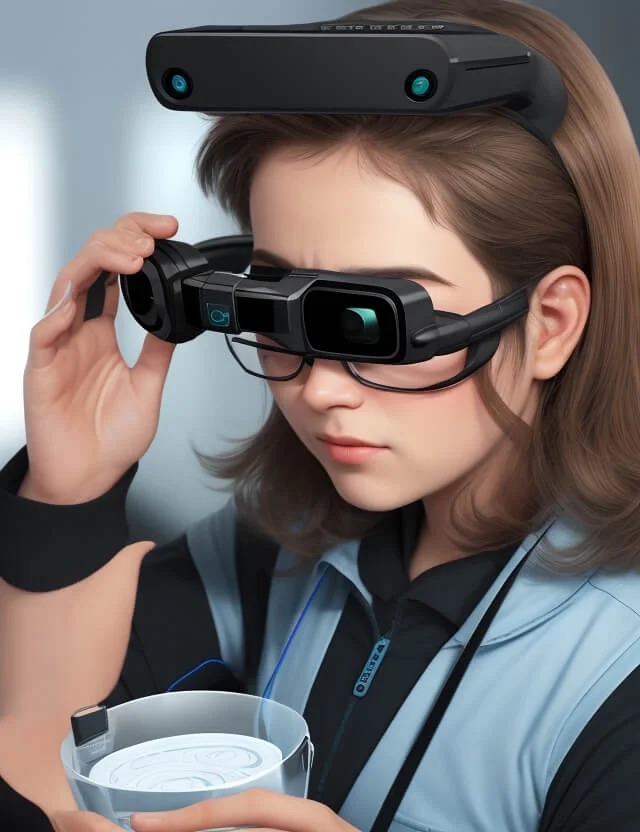Discover Advanced Assistive Devices for Individuals With Visual Impairments
The landscape of assistive innovation for individuals with visual disabilities is progressing quickly, providing a variety of ingenious gadgets that improve freedom and involvement. From smart glasses that seamlessly merge aesthetic input with acoustic advice to innovative navigating applications that redefine spatial understanding, these tools are reshaping opportunities.
Smart Glasses Innovations
Smart glasses represent a substantial development in assistive innovation for people with visual disabilities. Equipped with video cameras and sensors, wise glasses can record real-time aesthetic information, which is then refined and shared to the user with sound responses or haptic sensations.
Furthermore, improvements in artificial intelligence have additionally boosted the capabilities of smart glasses. Artificial intelligence formulas can identify faces, reviewed message, and recognize things, making them indispensable devices for everyday tasks. Users can receive acoustic hints that provide context concerning their atmosphere, fostering independence and confidence.
In addition, the ergonomic layout and light-weight nature of lots of smart glasses make them appropriate for extended use, guaranteeing comfort while improving functionality. As these tools remain to progress, they hold the potential to change the way people with visual problems experience their day-to-days live, linking the space in between access and modern technology. The continuous r & d in this area promise to increase the opportunities for smart glasses, making them an important part of modern-day assistive gadgets.
Navigation Application and Equipment
Numerous navigation apps and devices have actually become crucial resources for people with visual impairments, considerably improving their capability to go across strange settings. These innovations leverage general practitioner capability, audio cues, and real-time information to provide individuals with specific navigation aid.
One popular example is the Aira app, which connects individuals to trained representatives who can supply aesthetic descriptions of surroundings and navigation support through a live video feed. This solution enhances the individual's spatial awareness and self-confidence while browsing. One more notable device is Seeing Eye GPS, which supplies voice-guided navigating and sights, making it possible for customers to accessibility important information about their environments.

As innovation remains to advancement, the advancement of more advanced navigation devices assures to more empower people with aesthetic impairments, promoting seamless movement and integration right into varied atmospheres. Such developments contribute in promoting an extra comprehensive society.
Braille Modern Technology Improvements
In recent times, improvements in Braille technology have actually significantly changed just how individuals with visual problems access info and involve with the globe around them. The development of portable Braille screens has actually changed analysis by enabling customers to attach wirelessly to tablet computers, computers, and smart devices. These tools transform message into Braille in real-time, enabling seamless communication with electronic web content.
Moreover, innovative Braille printers have emerged, improving the production of tactile materials. Modern embossers are quicker and a lot more effective, enabling the quick production of Braille records and instructional products. This performance lowers the moment and price linked with generating Braille sources, next page making them a content lot more obtainable to companies and institutions.
Furthermore, the combination of Braille with other innovations, such as expert system and machine learning, has actually opened up new avenues for personalized learning experiences. Voice acknowledgment and synthesis innovations can match Braille, providing a comprehensive strategy to info dissemination.
As the need for inclusive education and office settings grows, these technical innovations play a crucial function in empowering people with visual disabilities, ensuring they have equivalent access to details and possibilities in different aspects of life.
Wearable Instruments for Self-reliance
A growing variety of wearable devices is boosting independence for people with visual problems, providing cutting-edge services that boost navigation and day-to-day living. Braille displays and notetakers. These devices make use of advanced modern technologies to offer real-time responses and support, advertising autonomy in different settings

Wearable innovation additionally consists of smartwatches that can be set with access features, enabling users to receive notifications, track their locations, or also ask for aid with the touch of a switch. In addition, some tools include expert system to assess the setting, offering sound summaries of close-by items or individuals.
Voice-Activated Assistive Solutions
Leveraging voice-activated assistive solutions has changed the landscape of assistance for individuals with visual problems, giving hands-free communication and access to a variety of jobs. These innovations utilize all-natural language handling and man-made knowledge to allow users to perform day-to-day tasks through simple voice commands.

Moreover, current developments in voice recognition precision have actually enhanced the individual experience dramatically, suiting diverse accents and speech patterns. This inclusivity makes sure that even more individuals can benefit from these technologies, cultivating a greater feeling of autonomy.
Verdict
To conclude, the growth of innovative assistive tools considerably boosts the self-reliance and top quality of life for people with visual impairments. Innovations such as smart glasses, navigation applications, Braille modern technology, wearable devices, and voice-activated remedies collectively foster an even more inclusive environment. These innovations empower users to browse their environments with confidence and involve more completely with the world, inevitably promoting greater availability and equal opportunities for people dealing with aesthetic challenges.
The landscape of assistive modern technology for people with visual impairments is advancing swiftly, offering a range of cutting-edge tools that improve freedom and engagement.Smart glasses represent a substantial improvement in assistive innovation for people with aesthetic disabilities. As these devices continue to develop, they hold the possible to reinvent the method individuals with visual problems experience their day-to-day lives, connecting the space between access and modern technology.In current years, improvements in Braille innovation have significantly changed exactly how individuals with aesthetic problems gain access to information and involve with the world around them. These technologies encourage individuals to navigate their environments with confidence and involve even more completely with the world, ultimately advertising greater accessibility and equivalent opportunities for people encountering visual obstacles.